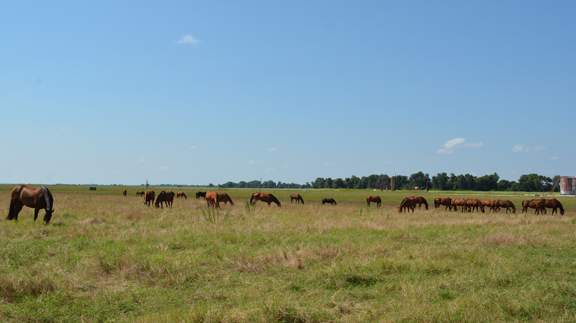Farm & Ranch
[AgriLife Today] Horse owners invited to participate in Texas equine study

By: Blair Fannin
Writer: Blair Fannin, 979-845-2259, [email protected]
Contact: Dr. James Heird, 979-845-0511, [email protected]
Dr. Rebekka Dudensing, 979-845-1719, [email protected]
COLLEGE STATION –Texas horse owners are invited to participate in a study of the Texas equine industry.
“The purpose of this study is to gather information about respondents’ horses and facilities, demographics, participation in the industry, horse-related expenditures and economic impacts,” said Dr. James Heird, executive professor and coordinator of the equine initiative at Texas A&M University in College Station. “Results of this study will be used by industry representatives, the Texas Department of Agriculture and other policy makers to respond to current needs of the state’s horse owners and related businesses.”
The study asks about horse ownership, participation in horse-related activities, boarding facilities, and horse-related expenditures. Owners of businesses that serve horse owners, such as feed stores, training facilities, farriers, and veterinarians, are also invited to participate in the survey.
The online survey can be accessed from the link: http://bit.ly/1R61UuH.
The survey will remain open through May 1. Survey participants must be at least 18 years old. The Texas Department of Agriculture along with industry professionals are sponsoring the study through the Texas A&M Equine Initiative to identify trends and issues in the Texas equine industry and to document the industry’s contribution to the state economy.
Studies by other researchers in 1998 and 2005 found that Texas was home to more horses than any other U.S. state and the horse industry was an important contributor to the state’s economy.
The current study will reflect changes within the industry and the statewide economy over the past 20 years.
Heird said a 2005 American Horse Council Foundation study found that Texas ranked No. 1 among U.S. states in the number of horses and that the Texas horse industry had a direct economic impact of $3 billion and an overall economic impact of $5.2 billion.
A comprehensive economic impact study on Texas’ equine industry has not been done since 2005, prompting a new survey to collect the most recent information, according to survey organizers.
-30-
LikeTweet
Find more stories, photos, videos and audio at http://today.agrilife.org
Farm & Ranch
Managing Show Cattle Through The Winter

By Heather Welper
Husband and wife duo, Heather and Calvin Welper, are the Co-Owners and Operators or Two C Livestock, located in Valley View, Texas.
The pair’s operation has a show cattle focus where they raise and sell purebred heifers of all breeds and club calf Hereford steers.
When it comes to show cattle, the Welpers know a thing or two including how to prepare for the cold winter months and the Texas major show season run.
To read more, pick up a copy of the November edition of North Texas Farm & Ranch magazine, available digitally and in print. To subscribe by mail, call 940-872-5922.

Farm & Ranch
Double M Ranch & Rescue

By Hannah Claxton, Editor
As the sun rises each day, so do the dozens of mouths that Meghan McGovern is responsible for getting fed. Rather than the sounds of a rooster crowing, McGovern hears the bellows and bleats of a variety of exotic deer, the chortle of kangaroos, the grunts of water buffaloes, and the chirps of a lemur.
Nestled against the banks of the Red River, the Double M Ranch and Rescue, with its high game fences and deer sprinkling the landscape,s its in stark contrast to the surrounding ranches.
“Having deer is kind of like eating potato chips- you can never actually have just one,” said McGovern with a laugh.
McGovern has several herds to take care of- fallow deer, axis deer, water buffalo, goats, and bison. In smaller numbers, there’s also a few kangaroos, a lemur, a potbelly pig, a pair of zebras, a watusi, and a few horses.
To read more, pick up a copy of the November edition of North Texas Farm & Ranch magazine, available digitally and in print. To subscribe by mail, call 940-872-5922.

Farm & Ranch
Acorn Toxicity

By Barry Whitworth, DVM, MPH
With the prolonged drought, most pastures in Oklahoma end up in poor condition. With the lack of available forage, animals may go in search of alternative foods.
If oak trees are in the pastures, acorns may be a favorite meal for some livestock in the fall. This may result in oak poisoning.
Oak leaves, twigs, buds, and acorns may be toxic to some animals when consumed.
To read more, pick up a copy of the November edition of North Texas Farm & Ranch magazine, available digitally and in print. To subscribe by mail, call 940-872-5922.

-

 Country Lifestyles2 years ago
Country Lifestyles2 years agoScott & Stacey Schumacher: A Growth Mindset
-

 Country Lifestyles8 years ago
Country Lifestyles8 years agoStyle Your Profile – What your style cowboy hat says about you and new trends in 2017
-

 HOME8 years ago
HOME8 years agoGrazing North Texas – Wilman Lovegrass
-

 Outdoor10 years ago
Outdoor10 years agoButtercup or Primrose?
-

 Country Lifestyles5 years ago
Country Lifestyles5 years agoAmber Crawford, Breakaway Roper
-

 Equine1 year ago
Equine1 year agoThe Will to Win
-

 Country Lifestyles9 years ago
Country Lifestyles9 years agoJune 2016 Profile – The man behind the mic: Bob Tallman
-

 Country Lifestyles8 years ago
Country Lifestyles8 years agoDecember 2016 Profile, Rusty Riddle – The Riddle Way




